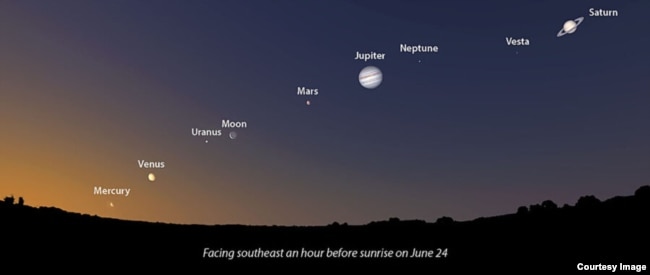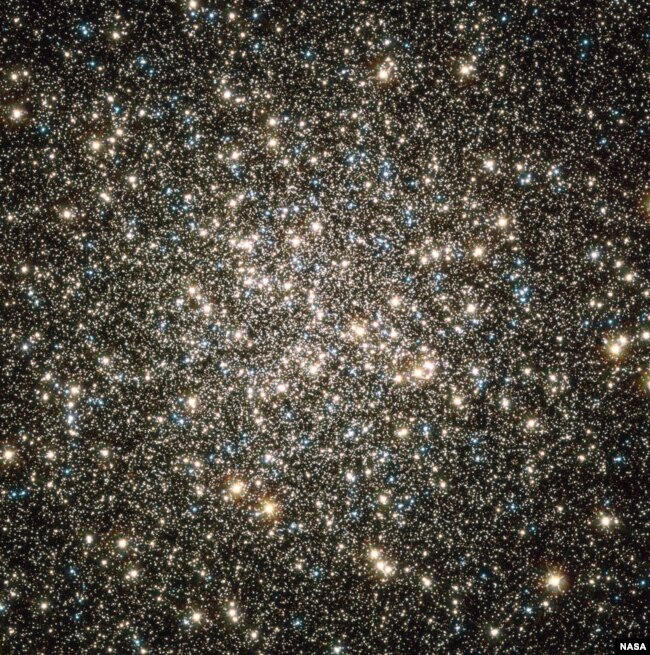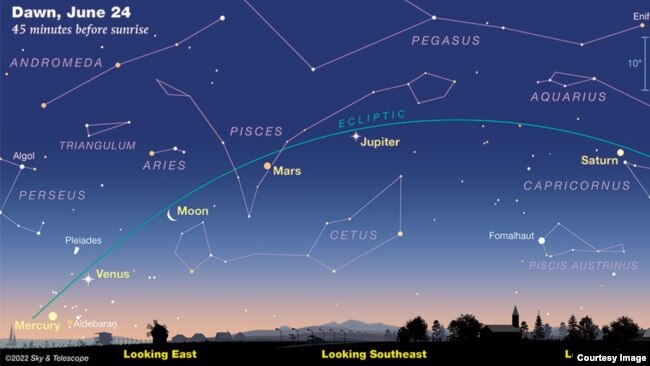何々!!!キャー!!!これは一大事!!
ニュースって、「・・・でした。」で報道されますよね。
悔しさに涙にじませながら聴いていたら。。。
”Astronomers say the formation is expected to remain in the sky through the rest of June.”
これで心に少し平穏が訪れ、涙を拭いました。
とはいえ、すかさず ”Stellarium" を起動し、チェック!
天体好きのスイスの友達にe-mail、『写真撮ったら送って〜〜』と忙しい彼に懇願!!
わたしの大好きな “crescent moon”も加わるなんて・・・息もできない!!
VOAで英語を学びましょう! !
6月24日
5つの惑星が天空に並ぶ珍しいフォーメーション(和訳)
5Planets Align in the Sky in Rare Formation
June 26,2022
太陽系の5つの主要な惑星が、スカイウォッチャーがその目で見ることのできる珍しいフォーメーションで並びました。
天文学者によると、このフォーメーションは6月いっぱいは空に残っている見込みです。その惑星とは、水星、金星、火星、木星、土星である。太陽系で最も明るい惑星です。
2つまたは3つの主要な惑星が互いに接近しているのを見るのは、よくある光景でしょう。しかし、アメリカ天文学会は声明の中で、5つすべてが一緒に見えることはまれだと述べています。このような惑星形成が最後に起こったのは、2004年12月でした。
同学会によると、5つの惑星を見るのに最適な時間は、太陽が昇る少し前だと言います。それらは、”東の低い位置から南の高い位置まで、空一面に広がるだろう”とのことです。
一部の天文学者は、このイベントを "惑星パレード "と呼んでいます。
天文協会の Sky & Telescope 誌が発表した地図では、左から水星、金星、火星、木星、土星の順で惑星が出現します。水星は地平線の最も低い位置に現れます。
北半球の人は東南東の地平線を、南半球の人は東北東の地平線を見ましょう。
望遠鏡などの特別な道具を使わなくても、惑星は見えるはずです。ただし、双眼鏡があると便利です。曇り空は見え方に影響を与えるので、天文学者は、最高の体験をするためにいくつかの計画を立てることを勧めます。
「もし、注目の日に曇りでも、その間の午前中には、南東の地平線を彩る5つの肉眼惑星を眺めることができます。」と、同学会は述べています。「目覚ましをセットして、時間通りに起きればいいのです。」
水星は太陽の光に近いので、最も見るのが難しいです。しかし、他の惑星は、双眼鏡を使わなくても、あと数日は簡単に見ることができるはずです。
6月19日、アメリカの宇宙機関NASAは、異常な惑星並びの始まりについてツイートしました。「今夜から星空を見上げると、金星、火星、木星、土星が広がり、空に並んでいるように見えます。」NASAは、6月23日に、”三日月”がラインナップに加わったことで、スカイウォッチャーが特別な扱いを受けたと指摘しています。
“crescent” ”三日月”とは、月が第1/4の初めから最終1/4の終わりまで見えるときの形を表しています。この時期は、月の端っこだけが見えていて、太陽に照らされている状態です。
6月が終わると、惑星パレードも終わりを迎える。天文学者は、次に5つの惑星の形成を見るチャンスは、2041年3月だと予測しています。
NASAによると、6月はより本格的なスカイウォッチャーにとって、最もよく知られた "球状星団 "の一つを観察する良い機会でもあります。これらの”星団”、グループ、は、中心で密接に集まった星の球状の集まりです。数万から数百万個の星が集まっていることもあります。この星団は、多くの銀河の中心を周回しています。
現在最も多く観測されているのはM13と呼ばれるもので、ヘラクレス星団としても知られています。しかし、宇宙機関は、それを見るには双眼鏡か望遠鏡が必要であると指摘しています。「M13はヘルクレス座にあり、6月の日没後の最初の数時間に東の高台にありますよ。」とNASAは助言しています。
星座とは、空の上で形を成している星の集まりのことで、名前が付けられ、その星座にまつわる物語があります。
M13に属する星は、約120億年前に誕生したと考えられています。これは宇宙そのものとほぼ同じ年齢であるとNASAは指摘しています。
5Planets Align in the Sky in Rare Formation
The five major planets in our solar system have lined up in a rare formation that sky watchers can see with their own eyes.
Astronomers say the formation is expected to remain in the sky through the rest of June. The planets involved are Mercury, Venus, Mars, Jupiter and Saturn. They are the brightest planets in the solar system.
Seeing two or three major planets close to each other can be a common sight. But the American Astronomical Society said in a statement that seeing all five together is rare. The last time such a planet formation happened was in December 2004.
The society said the best time to watch the five planets is shortly before the sun rises. They will be “stretching across the sky from low in the east to higher in the south,” the statement said.
Some astronomers are calling the event a “planet parade.”
A map published by the Astronomical Society’s Sky & Telescope magazine shows the planets appearing from left to right in this order – Mercury, Venus, Mars, Jupiter and Saturn. Mercury will appear at the lowest point on the horizon.
People in the Northern Hemisphere should look toward the east-southeast horizon, while those in the Southern Hemisphere should be looking toward the east-northeastern horizon.
The planets should be visible without special equipment such as a telescope. But binoculars will be helpful. Cloudy weather will also affect visibility, so astronomers suggest some planning for the best experience.
“If it’s cloudy on the dates of note, you still have all the mornings in between to take in the view of the five naked-eye planets adorning the southeastern horizon,” the society said. “Just make sure you set your alarm and wake up on time.”
Mercury is the most difficult to see because it is closer to the glow of the sun. But the other planets should be easy to see, even without the use of binoculars, for several more days.
On June 19th, the American Space Agency NASA tweeted about the beginning of the unusual planet lineup. “Look up starting tonight to see Venus, Mars, Jupiter and Saturn spread out and appear to line up in the sky.” NASA noted that on June 23, sky watchers got a special treat, when the “crescent moon” joined the lineup.
A “crescent” describes the shape of the moon as it appears early in its first quarter or late in its last quarter. During this period, only a small edge of the moon is visible and is lit up by the sun.
As June ends, the planet parade will come to an end. Astronomers predict the next chance to see the five-planet formation will be March 2041.
NASA says June is also a good time for more serious sky watchers to observe one of the best-known “globular star clusters.” These “clusters,” or groups, are spherical collections of stars gathered closely together at their centers. They can include tens of thousands to millions of stars. They orbit the centers of many galaxies.
The one currently most observable is called M13, also known as the Hercules Cluster. But the space agency notes that binoculars or a telescope will be necessary to see it. “Find M13 in the constellation Hercules, which is high in the east in the first couple of hours after dark in June,” NASA advises.
A constellation is a group of stars that forms a shape in the sky and has been given a name and has a story behind it.
The stars in M13 are thought to be around 12 billion years old. That is nearly as old as the universe itself, NASA notes.
Words in This Story
horizon – n. where the sky seems to touch the land or sea
visible – adj. able to be seen
binoculars – n. a pair of tubes with glass lenses at the ends that you look through to see things far away
the naked eye – n. if something can be seen with the naked eye, it can be seen without the help of special equipment
adorn – v. to add something decorative to a person or thing
glow – v. to produce a continuous light and sometimes heat
spherical – adj. something with a round shape, like a ball
galaxy – n. one of the independent groups of stars in the universe


